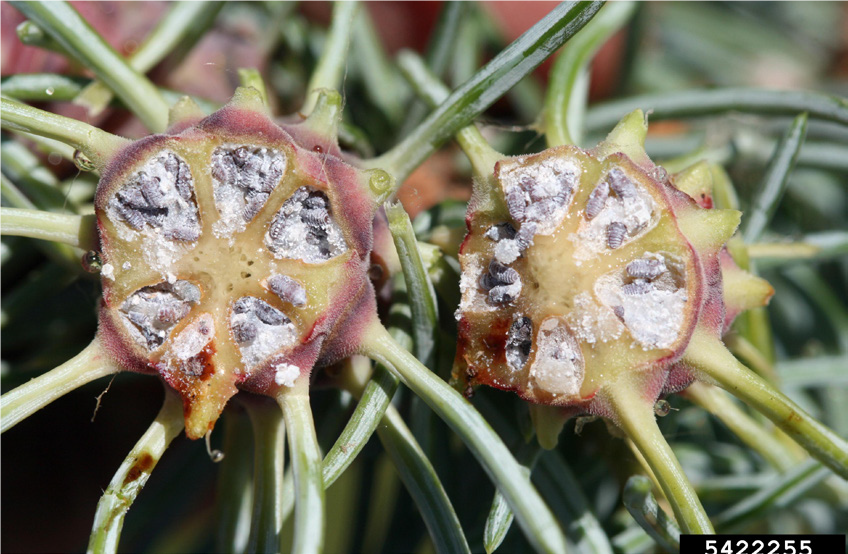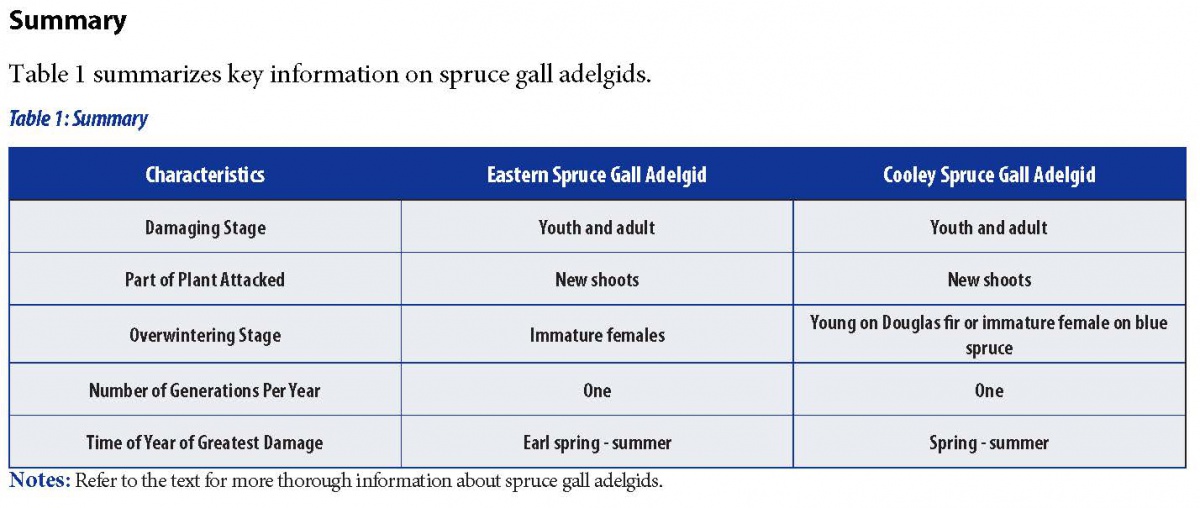Most spruce trees are damaged by one of two species of adelgids: the Eastern spruce gall adelgid (Adelges abietis) and the Cooley spruce gall adelgid (Adelges cooleyi). With their sucking mouth-parts, these adelgids feed on plant juices, causing an irritation that results in plant tissue developing into cone-like galls characteristic in form and shape for the aphid species involved. Continued infestations disfigures ornamental and Christmas trees, weakening them, and making them subject to attack by other pest organisms.

within gall chamber. Credit: Whitney Cranshaw,
Colorado State University, Bugwood.org.
Description and Life Cycle
Eastern Spruce Gall Adelgid: Galls caused by this insect occur mostly on Norway, white, black, and red spruce trees. An infestation does not spread rapidly from one tree to another. It is not unusual to find specific trees in a planting rather heavily infested year after year while others of the same species may escape injury. There is also a wide range of resistance to this insect within the same tree species.
The eastern spruce gall adelgid spends winter as an immature female, usually located in a crevice at the base of a spruce bud. It begins feeding in early spring and in May it deposits a mass of eggs covered with waxy threads. The eggs hatch when the shucks break away from the bud and expose the new needles.
The newly hatched adelgids crawl into the mass of new needles to feed. The swelling needle bases develop into a compact mass and form a pineapple-shaped gall. Each gall has many individual cells, inhabited by many adelgids. In late September, the cells open and the adelgids escape. These escapees produce the individuals which live through winter.
Cooley Spruce Gall adelgid: Galls caused by the Cooley spruce gall adelgid occur on Colorado blue spruce, Sitka spruce, and Engelmann spruce. The galls are somewhat larger than those caused by the Eastern spruce gall adelgid and occur on the tips of twigs. The growing gall varies from light green to dark purple. It may be 1” to 2” in length and ¼” to ½” in diameter.
When it remains on spruce, the life history of this adelgid is similar to that of the Eastern spruce gall adelgid. However, some of the mature adelgids emerging from a gall in July or August fly to Douglas fir to lay eggs. The eggs hatch into young adelgids which spend winter on fir and produce a new brood in spring when growth appears. These feed on new growth and cause distortion but do not form galls. This adelgid does not need both hosts to complete its life cycle but is more serious when both hosts are present. Do not grow Douglas fir and spruce together.

Whitney Cranshaw, Colorado State University,
Bugwood. org.
Management
IPM Strategies:
- Cultural Practices - When practical, remove green colored galls on spruce during June or July before adult adelgids emerge; this practice will manage infestations on a few small trees. Removing and destroying dried galls will have no effect on the pest population since the insect has already emerged from the gall.
- Chemical Control - Apply registered insecticides according to label directions to spruce from mid-September through early October to manage overwintering immature females.
Consult your county Extension Field Specialist for specific pesticide recommendations.

Stop! Read the label on every pesticide container each time before using the material. Pesticides must be applied only as directed on the label to be in compliance with the law. All pesticides listed in this publication are contingent upon continued registration. Contact the Division of Pesticide Control at (603) 271-3550 to check registration status. Dispose of empty containers safely, according to New Hampshire regulations.
Download the resource for the complete factsheet.
